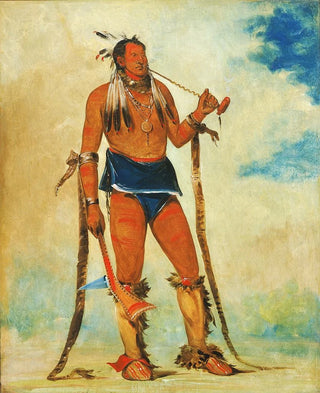Art print | WahCheeHhsKa The man who puts everything outside - George Catlin


View from behind

Frame (optional)
The artwork "WahCheeHhsKa L'homme qui met tout à l'extérieur" by George Catlin is a true invitation to immerse oneself in the fascinating world of Native American cultures. Through this art print, the artist transports us to a moment in history when the traditions and lifestyles of indigenous peoples were both rich and undergoing rapid change. Catlin, as a perceptive observer, offers a vivid and authentic representation of his subjects, capturing not only their physical features but also their spiritual essence. This art print allows us to relive this unique experience, where every detail is a gateway to a deeper understanding of these often little-known societies.
Style and uniqueness of the work
Catlin's style is distinguished by its ability to combine realism and romanticism. In "WahCheeHhsKa L'homme qui met tout à l'extérieur," the artist uses a palette of vibrant colors and dynamic compositions that reflect his admiration for Native American culture. The gestures, postures, and expressions of the characters are rendered with an almost photographic precision, while maintaining a poetic dimension that transcends mere portraiture. This piece does not simply depict an individual; it tells a story, that of a people and their traditions. The way Catlin stages his subject, emphasizing cultural and symbolic elements, gives the work a depth that invites reflection and wonder.
The artist and his influence
George Catlin, 19th-century painter and explorer, dedicated much of his life to documenting the lifestyles of Native Americans. His commitment to preserving these cultures, then threatened by colonial expansion, made him an emblematic figure of ethnographic art. Through his works, he not only captured the beauty of indigenous peoples but also raised awareness about their precarious situation. Catlin was able to combine his artistic talent with a social mission, seeking to sensitize the public to the values and traditions of these societies. His influence endures today, inspiring many artists and historians to continue this quest for understanding and respect for

Matte finish

View from behind

Frame (optional)
The artwork "WahCheeHhsKa L'homme qui met tout à l'extérieur" by George Catlin is a true invitation to immerse oneself in the fascinating world of Native American cultures. Through this art print, the artist transports us to a moment in history when the traditions and lifestyles of indigenous peoples were both rich and undergoing rapid change. Catlin, as a perceptive observer, offers a vivid and authentic representation of his subjects, capturing not only their physical features but also their spiritual essence. This art print allows us to relive this unique experience, where every detail is a gateway to a deeper understanding of these often little-known societies.
Style and uniqueness of the work
Catlin's style is distinguished by its ability to combine realism and romanticism. In "WahCheeHhsKa L'homme qui met tout à l'extérieur," the artist uses a palette of vibrant colors and dynamic compositions that reflect his admiration for Native American culture. The gestures, postures, and expressions of the characters are rendered with an almost photographic precision, while maintaining a poetic dimension that transcends mere portraiture. This piece does not simply depict an individual; it tells a story, that of a people and their traditions. The way Catlin stages his subject, emphasizing cultural and symbolic elements, gives the work a depth that invites reflection and wonder.
The artist and his influence
George Catlin, 19th-century painter and explorer, dedicated much of his life to documenting the lifestyles of Native Americans. His commitment to preserving these cultures, then threatened by colonial expansion, made him an emblematic figure of ethnographic art. Through his works, he not only captured the beauty of indigenous peoples but also raised awareness about their precarious situation. Catlin was able to combine his artistic talent with a social mission, seeking to sensitize the public to the values and traditions of these societies. His influence endures today, inspiring many artists and historians to continue this quest for understanding and respect for






